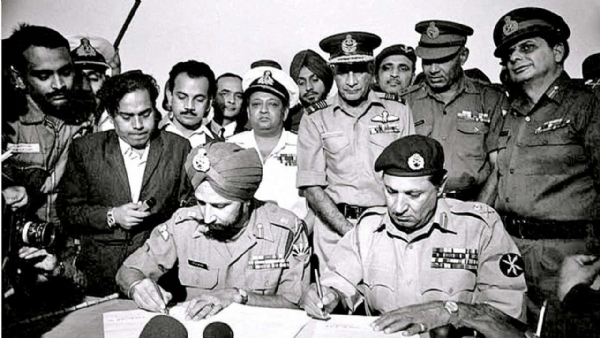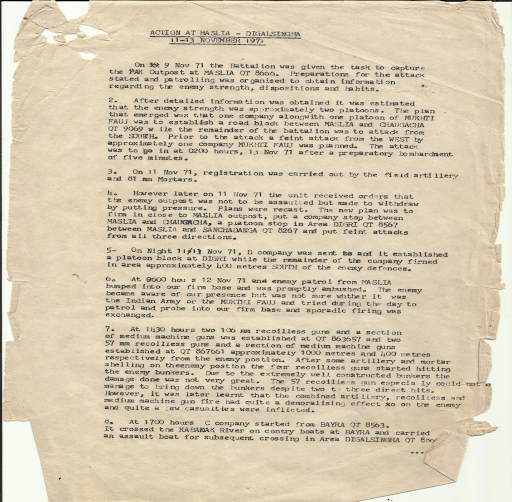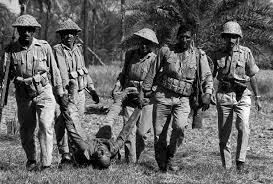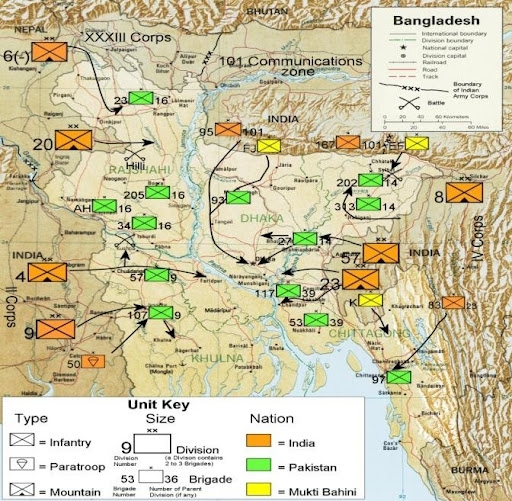1971 War: Truth vs. Distorted History
Why are the Indian authorities still not declassifying the real historical account of battles even after 50-years? In particular, when the Defense Minister in June 2021 has specified 25-years timeline for declassification of classified material?
Total Views |
The 1971 Liberation War of East Pakistan continues to be celebrated as 14-day war ((from 3 December 1971 to the fall of Dacca (Dhaka) on 16 December 1971) even after 50 years. Visual media goes blaring away that the 1971 war began with preemptive Pakistani aerial strikes on 3 December 1971 on 11 Indian air stations in the Western Sector and glorify the battles fought in the Western Sector. It is portrayed casus belli for launching Indian offensive into East Pakistan in support of Bangladeshi nationalist forces.
How long will truth are obfuscated? Why deny credit to those who sacrificed their lives and units.
Why are the Indian authorities still not declassifying the real historical account of battles even after 50-years? In particular, when the Defense Minister in June 2021 has specified 25-years timeline for declassification of classified material?

Surely, current “Historian Emeritus's” are available to carry out research, pay visits and interview those still surviving to retrace detailed accounts of battles and record them for posterity.
Irrefutable political compulsion was the need to show to the international powers that the Provisional Government of Bangladesh which was formed on 17 April 1971 and operating from Calcutta as "Government in Exile", was functioning from inside East Pakistan. So, the initiative to secure a lodgment area inside Bangladesh so that the Bangladesh government would request international diplomatic recognition and intervention. When the attacks in Hilli-Bogra area failed to make a dent, 350 Infantry Brigade (9 Infantry Division) was tasked to capture MASLIA BOP opposite BOYRA BULGE and establish lodgment area opposite CHAUGACHA. So, many gallant actions were fought before 3 December 1971 in East Pakistan that forced Pakistan to launch airstrikes in the Western Sector.
As Brigade Major of 350 Infantry Brigade, responsible for the operational conduct of battles in Jessore-Khulna Sectors, let me highlight that actual operations were launched on night 11/12 November 1971 with 1 JAKRIF crossing the border to capture the Pakistan’s MASLI BOP – EAST of Boyra salient in Jessore Sector. At the last moment, orders were received to ‘invest’ the BOP instead of capture to prevent Pakistan from capturing Indian prisoners and using them to launch propaganda against Indian involvement. 45 CAV less one Squadron was deployed in support of 1 JAKRIF.

Meanwhile, by 15 November 1971, company of 4 SIKH (Not 2 Sikh as covered in IDS) was deployed in area MAKAPUR, NORTH of Boyra salient to provide flank security to 1 JAKRIF and to invest BARNI BOP in the North. By 17 November 1971, remaining battalion of 4 SIKH was also deployed in area MAKAPUR, NAODAPARA, NAYRAPARA and HIJULI to exploit and expand the lodgment area.
Also, one company each of 26 MADRAS deployed in area GARIBPUR and Muhammadpur to provide flank security from the Southern flank and one company to exploit and expand lodgment area up to DOSATINA.
Meanwhile, orders to enlarge the bridge head across River Kabadak were received with a view to build up armor and artillery deployment to support attack on “JESSORE FORTRESS”. On night 18/19 November 1971, 102 Engineer Regiment constructed the “Krupman Bridge” over River Kabadak. The first Pakistani air strike by 4 x F86 Saber fighters took place on at 10.50 A.M. on 19 November 1971. They destroyed one pontoon of the bridge before GNATS from KALAIKONDA air base scrambled could appear on the scene. Subsequently, one flight of Gnats was deployed in the forward air base at Dum Dum. By 20.30 P.M., 19 November 1971, B Squadron, 63 CAV was deployed under 4 Sikh.
Pakistan army launched probing patrols against the lodgments secured opposite the BOP. Extract of debriefing of Brigadier Hayat Khan in the POW Camp in Ranchi are reproduced: “As there were no crossing places on River Kabadak opposite Chaugacha, I did not visualize a major threat. However, I reinforced the BOP with regulars. During the course of operations, I decided to counter attack lodgment areas astride the river with one battalion which failed to evict your forces.”
On receipt of intelligence of withdrawal of Pak troops from BARNI post area, on 20 November 1971, 4 SIKH advanced and secured all areas West of CHAUGACHA on main road leading to Jessore from North West held by Pakistan’s 38 FF. On orders, 4 SIKH was directed to halt further offensive and not to cross the River Kabadak.
Next, by 3 A.M on 21 November 1971, 14 Punjab battalion (Ex 42 Infantry Brigade) was deployed in area GARIBPUR with C Squadron 45 CAV (PT 76s) wading through the River Kabadak in support of 14 PUNJAB firm base. On the morning of 21 November 1971, the famous tank battle of Garibpur was fought. Pakistan's 107 Infantry Brigade launched a counter attack with 3rd Independent Armored Squadron after dawn. Pakistani armor rushed headlong into armor lying in wait. Major D.S. Narang, Squadron Commander, led the engagement standing with his half body outside the cupola. He was hit by enemy MMG fire and died (Awarded Maha Vir Chakra).
After a fierce engagement, 11 enemy tanks were destroyed. The destroyed Pakistani tanks were recovered and moved inside Boyra Bulge. Jagjivan Ram, Defense Minister, addressed troops congratulating them for their valor (picture was featured in media).A second Pakistani air strike was launched at 14.50 PM on 22 November 1971 with three Pakistan fighters engaging forces deployed in lodgment areas across the border. The flight of Gnats at Dum Dum appeared on the tail of hostile aircraft as they were strafing and destroyed them. Flight Lieutenant Parvez Qureshi Mehdi, who bailed out (served as the PAF Chief of Air Staff from 1997 to 2000 - during the 1999 Kargil War) was captured by 4 SIKH.
On 22 November 1971, on receipt of information of withdrawal of Pakistan troops from BOPs, troops advanced and secured all areas including Chaugacha on the road to Jessore by early morning 23 November 1971. The Time Magazine of November 1971 reported “an embarrassing victory at Boyra” in November 1971.Finally, 350 Infantry Brigade was redeployed west of Jessore and 42 Infantry Brigade deployed North West astride road Chaugacha-Jessore for executing further offensive operations against “Jessore Fortress” on outbreak of war. 350 Infantry Brigade was given the task of expanding the Bridge head to facilitate deployment of artillery for the main battle against Fortress Jessore. 1 JAK Rifles attacked BURINDA on the night of 28/29 November with one company supported by one troop of Tanks. The attack was repulsed. 1 JAK Rifles suffered heavy casualties: Killed - 3 JCOs and 16 OR; and injured over 50 personnel.

Subsequently, 4 Sikh was redeployed and tasked to capture 8 R-BURINDA on 3/4 December 1971. 8 R-BURINDA was captured after a fierce battle fought over 5/6 December 2017 with the battalion suffering casualties: killed - 1 JCO and 15 OR; and injured - 1 Officer, 3 JCOs and 52 OR. Never too late after 50-years to reconcile different versions on the “Battle of Garibpur”. Similarly, the Air Force version of scrambling of aircraft in the second instance from Kalaikonda needs to be rectified to read GNATS were scrambled from DUM DUM. No classic dog fight took place. As the Pak SABRES were diving to hit the ground targets, the GNATS shot them down.
Battle of Khulna in Brief
Pakistani troops withdrew towards Khulna and put up a last ditch stand based on built-up area. Followed the unsuccessful attempts by 13 DOGRA of 32 Infantry Brigade to clear SIRAMANI on 12 December 1971. Even the attempts to outflank SIRAMANI enemy positions by the 19 MARATHA LIGHT INFANTRY from the EAST and 8 MADRAS FROM the WEST failed.
350 Infantry Brigade was moved from JESSORE outskirts and tasked to break through the SIRAMANI positions and clear KHULNA. 26 MADRAS attack on 13 December 1971 was also repulsed with heavy casualties. Anticipating fierce resistance, the attack by 1 JAK Rif was postponed to make a beaten road through the jungle to forming Up Place (FUP). On 14 December 1971, 1 JAK Rif captured SYAMGANJ WEST of Bhairab River. By 1630 hours, 4 SIKH was deployed through 1 JAK Rif firm base to capture and establish road block astride the main JESSORE-KHULNA Road, which was successfully accomplished by 0700 hours on 16 December 1971. And, the Pakistani brigade formally surrendered on 17 December 1971; not on 16 December 1971.

By the count of casualties suffered by the three units of 350 Infantry Brigade, one can easily discern the fierceness of battles waged and gallantry displayed: 1 JAK RIF - Killed 50 and wounded 145; 4 SIKH - Killed 36 and wounded 169; and 26 MADRAS suffered 6 officers, 4 JCOs and 68 killed/wounded . Ironic that the actions of units of supporting arms - artillery, engineers and signals - in facilitating successful conduct of operations by infantry units remain unrecognized particularly in the award of at least " Theater Honors".
In sum, the foregoing narrative clearly exposes two key myths or mystery surrounding 1971 war. For the formations and troops of II Corps, 9 Infantry Division and 350 Infantry Brigade, it was a 36/37-day war; but not a 14-day war. Many bold and gallant actions were fought and large numbers martyred.
Next, it is also a myth that armed forces were given a free hand to conduct operations in the Eastern Front from day one. Political directions dictated plans and course of battle from time to time. The original plan of a “Rapid Thrust (Deep Penetration Thrust)” from Boyra Bulge bypassing JESSORE to secure GOLONDO Ghats was changed to suit political needs for demonstrating that Mukhti Bahani (Bangladesh Government in exile) is operating from within East Pakistan.
Thus, the true facts of the battles of 1971 Liberation War, particularly the Battles of Boyra and Khulna, have been obfuscated. By not declassifying the operational reports, successive regimes have rendered disservice to the departed souls and their families. Surely, families should be extended all the benefits on par with battle casualties today. Just as posthumous awards are given in civilian cases, at least Theatre Honors may be awarded to engineers, artillery and signal units that contributed handsomely for the successful Liberation of Bangladesh.
